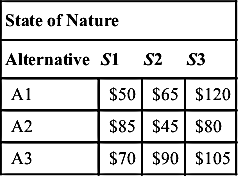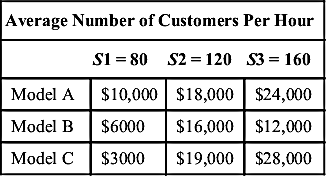Questions and Exercises
1. If the weighting factors listed in Table 2.3 are revised as Strength: 2, Weight: 4, Machinability: 3, Corrosion resistance: 5, and Material cost: 3, which material among the five is desirable to be used?
2. A manufacturing firm is moving to absorb some short-term excess production capacity at one of its plants. The firm is considering a short manufacturing run for either of two new products, a coffee maker or a blender. The market for each product is known if the products can be successfully developed. However, there is some chance that it will not be possible to successfully develop them. Revenue of $1,000,000 would be realized from selling the coffee maker and revenue of $400,000 would be realized from selling the blender. Both of these amounts are net of production cost but do not include development cost. If development is unsuccessful for a product, then there will be no sales, and the development cost will be totally lost. Development cost would be $100,000 for the coffee maker and $10,000 for the blender. Suppose that the probability of development success is 0.5 for the coffee maker and 0.8 for the blender. Sketch a decision tree diagram to describe the problem and calculate the payoffs to help the firm make an adequate decision.
3. The following payoff table was developed. Let P(S1) = 0.25, P(S2) = 0.55, and P(S3) = 0.20. Compute the expected monetary value for each of the alternatives. What decision would you recommend?
| State of Nature | |||
| Alternative | S1 | S2 | S3 |
| A1 | $50 | $65 | $120 |
| A2 | $85 | $45 | $80 |
| A3 | $70 | $90 | $105 |

4. An agriculture manufacturing company has seen its business expanded to the point where it needs to increase production beyond its existing capacity. It has narrowed the alternatives to two approaches to increase the maximum production capacity:
a. Expansion, at a cost of $8 million, or
b. Modernization at a cost of $5 million
Both approaches would require the same amount of time for implementation. Management believes that over the required payback period, demand will either be high or moderate. Because high demand is considered to be somewhat less likely than moderate demand, the probability of high demand has been estimated at 0.35. If the demand is high, expansion would gross an estimated additional $12 million but modernization only an additional $6 million, due to lower maximum production capability. On the other hand, if the demand is moderate, the comparable figures would be $7 million for expansion and $5 million for modernization. Calculate the EMV for each course of action, (a) and (b).
5. A steak house is contemplating opening a new restaurant on Main Street. It has three different models, each with a different seating capacity. They estimate that the average number of customers per hour will be 80, 120, or 160. The payoff table (profits) for the three models is developed as shown in the table below,
| Average Number of Customers Per Hour | |||
| S1 = 80 | S2 = 120 | S3 = 160 | |
| Model A | $10,000 | $18,000 | $24,000 |
| Model B | $6000 | $16,000 | $12,000 |
| Model C | $3000 | $19,000 | $28,000 |

Calculate the expected value for each decision.
6. On a busy highway in an urban area, speeding is common. A speeding ticket costs an amount of t > 0. Some people drive aggressively and drive over the speed limit. There is a probability p > 0 of being caught, which leads to a fine f > t. In order to slow down the drivers on the busy highway, there are two possible concepts: doubling the fine f or doubling the patrols (i.e., the probability p). Assuming that the drivers are risk-averse, risk-neutral, and risk-prone, which is the better concept for these three kinds of drivers respectively—double the fine or double the patrols?
7. Jeff is an e-trader. Suppose that Jeff's utility as a function of the money he has in his trading account, x, is given by U(x) = ln x (the natural logarithm of x).
a. Is Jeff risk averse? Explain why or why not.
b. Jeff now has $10,000 and two possible decisions. For decision 1, he loses $500 for certain (by paying the required fees to keep trading). For decision 2, he loses $0 with probability 0.9 and loses $5000 with probability 0.1. Which decision maximizes the expected utility of his money in the account?
9. Formulate the unconstrained beam design problem, as discussed in Section 2.6.1.1, as a strategy form game. Find the Nash equilibrium of this problem.
10. Solve the beam design problem shown in Section 2.6.1.1. In this case, instead of a cantilever beam, assume that the beam is clamped at both ends. Solve this unconstrained problem for the following cases:
Case 1: The designer is risk neutral with preferences kw = 0.5, kz = 0.5.
Case 3: The designer is risk neutral with preferences kw = 0.8, kz = 0.2.
Compare the results of the three cases and make observations in terms of the influences of attitude toward risk and preferences to the solutions.
..................Content has been hidden....................
You can't read the all page of ebook, please click here login for view all page.
